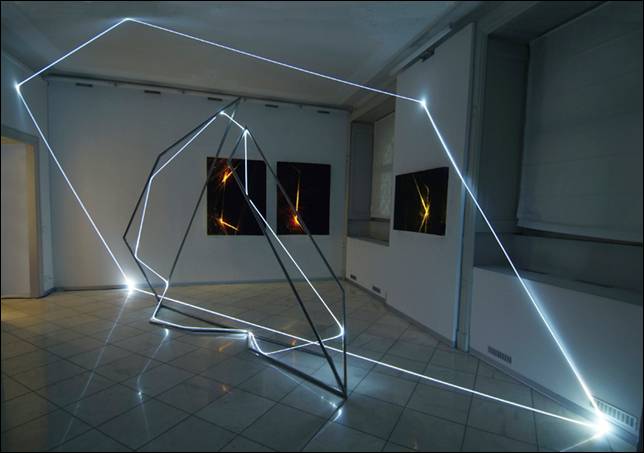
Permeable Space
CARLO BERNARDINI was born in Viterbo in 1966 and obtained his diploma at the Fine Arts Academy in Rome in 1987.
In 1997 he wrote the theoretical essay on "The division of visual unity", which was published by Stampa Alternativa.
In 2000 and 2005 he received a grant "Overseas Grantee" from the Pollock - Krasner Foundation of New York, and in 2002 the prize Targetti Art Light Collection “White Sculpture”. He has created and installed permanent public sculptures in stainless steel and optic fibres in various Italian cities.
He currently teaches at the Fine Arts Academy of “Brera” in Milan. He lives and works both in Rome and Milan.
Carlo Bernardini is devoted to the dialectic relation between lines and monochrome, representing different moments of the figurative conception of space and light. The painstaking path of abstraction, far from being a sole intellectual strategy, is a gradual research of the line element in order to conquer its essence, as if to trace the invisible.
His visual research is currently developed by means of environmental installations in optic fibres.
His is a form of creativity that works on the basis of a code of modifications in space reflecting variants produced by light. So much is confirmed by the present research of Carlo Bernardini, who handles light and shade like materials and substances, using electro-luminescent surfaces and opticalal fibres with internal lighting in a context of total darkness.
In these works with interior and exterior environmental light installations, the optical superimposition of lines traversing a space and lines running along the planes of the same space, viewed from a certain position, can produce two-dimensional visual conditions.
Closing one eye, transforming it into a single lens, the image becomes two-dimensional; as soon as the viewpoint shifts volumetric changes come about, generating mirror image-forms .
The first impression is not of the optical fibers themselves, but rather of transparent plates of glass lit up along the sides .
The optical fibers only reveal the empty space they enclose in a subsequent phase of perception .
The observer can enter into a sort of illusory space, experiencing the installation from within and without .
PERMEABLE SPACE
Design combines construction of the image with the thought that gives it origin.
A perimetric design brings unity to the inner void and tends to concentrate the greatest force within it.
However, this force in turn generates ambivalence, breaking into the margins of the space within the form.
Thus, on the basis of this ambivalence - this transformation of one reality into another - the concept of transmutation of an environmental, traversable space poises the viewpoint between two hypothetical positions, one internal, the other external; between one form of objectivity viewed from outside and another perceived from within.
The optical superimposition of lines traversing a space and lines running along the planes of the same space, viewed from a certain position, can produce two-dimensional visual conditions; as soon as the viewpoint shifts volumetric changes come about, generating mirror-image forms.
Thus such changes can generate properties able to permeate a place.
A so-called "permeable" space can therefore be a virtual space tending to exert force on the limit of physical space.
Alternatively, it will tend to enclose a real environment within an illusory volume.
One seeks to break through the interior of the other.
Here the perception of the eye may itself feel called into question, seeking the escape route from the limits of a form.
Thus the idea of a permeable space becomes design on the transformation of the coordinates of physical space.
If the line delimiting it apparently concentrates both volume and void, it can itself reverse those coordinates, the former giving way to the latter and vice-versa.
It is as if volume were annihilated in a flat dimension while void acted as fulcrum to an illusory dimension.
Thus we have a sort of space within space.
There are two things alone that have in themselves a visible but immaterial property to approach this concept, namely light and shade.
Shade can take shape on the surfaces of a physical space, or can fill the entire volume with darkness, but it cannot traverse it.
Thus only light remains.
Rome, 2000
Carlo Bernardini
